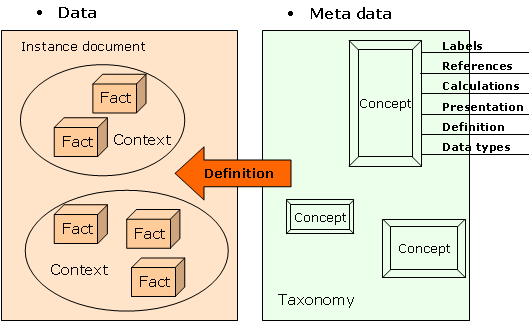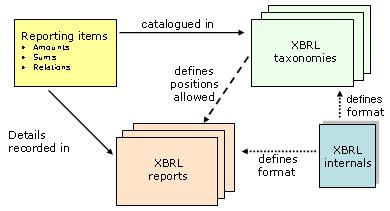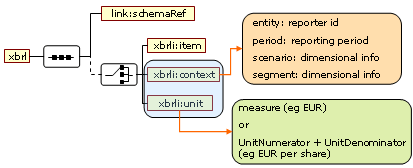Best Practices on Creating Instances based on CEBS Taxonomies
From XBRLWiki
(diff) ←Older revision | Current revision | Newer revision→ (diff)
Contents |
Abstract
This document describes the best practices on how to create instance documents based on extensions of CEBS (Committee of European Banking Supervisors) taxonomies. The document provides only a best practice view as orientation for supervisors adopting COREP and/or FINREP taxonomies of the CEBS, the national definition might differ and have special characteristics.
The Committee of European Banking Supervisors (CEBS) has published XBRL taxonomies for the common reporting framework COREP (COmmon REPorting) for the new solvency ratio for credit institutions and investment firms and for the standardised financial reporting framework (FINREP) for credit institutions operating in the EU. These taxonomies are available on the website of the CEBS http://www.c-ebs.org and on the project related websites http://www.corep.info and http://www.finrep.info. Comment
Status
This draft document is created by members of the XBRL network of the CEBS. Taxonomy editors that are extending the CEBS taxonomies (COREP and/or FINREP) are invited to add comments, experiences and suggestions for improvement on how to define the general rules for the creation of instance documents.
| KS: The following documentation is an abstract of the explanatory information on reports for the German COREP reporting. |
Basic principles of XBRL
Definition
XBRL
- stands for eXtensible Business Reporting Language.
- is a freely available electronic language used for financial reporting.
- provides a standard basis for the compilation, publication, evaluation and comparison of information supplied by and relating to enterprises.
- is an XML–based language
Area of application
XBRL was originally developed to enable a wide range of recipients such as banks, auditors, authorities and the stock exchange to process corporate information, eg balance sheets, in a standardised format. Nowadays, XBRL can also be used to create all kinds of company reports. Using software which supports the XBRL standard, the recipient can access the information content and see it displayed in the adapted format.
A standardised format shared by a large number of data recipients and data submitters represents the way forward in terms of processing data more quickly and more cost-effectively while simultaneously improving quality.
XBRL framework
XBRL defines a syntax in which information relevant to reporting is represented as the value of a concept within a defined context. Concepts are XML-based tags embedded in XBRL taxonomies. Standardisation in XBRL is achieved by grouping generally valid tags from XBRL associations into XBRL taxonomies. These can then be used and, if necessary, enhanced by authorities, financial institutions and other enterprises to define their data transfers.
The European COREP taxonomy used by the CEBS (Committee of European Banking Supervisors) represents the base taxonomy for solvency reporting. This is then adapted by the individual national central banks to meet their own reporting requirements. The COREP taxonomy is the implemented version of the COREP (Common Reporting) framework - that is to say of a uniform, European solvency reporting system for credit institutions and other financial service providers based on Basel II directives - in XBRL format.
Concepts are defined within the XBRL taxonomies, each of which gives information relevant to reporting. For example, concepts contain a name and a type. The type specifies the unit of measurement that is to be used for reporting purposes, eg a monetary or an integer value. Concepts are derived from the XBRL item element.
The relationship between individual concepts is defined by so-called XBRL linkbases. These also define any supplementary information such as references or descriptions (labels). In order to link these supplementary pieces of information with the XBRL taxonomies, XBRL uses technology called XML Linking (XLink). Using this technology it is possible to link XML files as well as to illustrate relationships between two or more elements.
Hence, taxonomies merely describe what is to be reported and do not actually contain any up-to-date figures concerning the report content as it is defined. These values are reported in the XBRL instance documents, eg capital requirements: 500,000. A concept that is represented in conjunction with its own specific value and contained within an instance is called a “fact”.
XBRL instance documents, which are also known as XBRL reports, may refer to one or more XBRL taxonomies. They also include a host of contextual information, such as the reporting period or the reporting party’s ID number, which is vital for interpreting the reported data. All units of measurement and currency are likewise defined in the instance documents.
An XBRL instance document taken in conjunction with its supporting taxonomies and their linkbases constitutes an XBRL business report.
XBRL instance documents
XBRL instance documents, known in short as XBRL instances, are XML-based files and must therefore correspond to XML format requirements. Foremost among these are the four rules which determine whether an XML document is properly structured, ie
- The start tag used in the element must match the end tag.
- Elements must be correctly nested.
- The document must include a root element that encapsulates all of the other elements.
- Elements and attributes must be given valid names.
Since XBRL taxonomies are also XML scheme files, XBRL instances that refer to XBRL taxonomies need to match the XML schema rules defined in those taxonomies if they are to be valid documents. Consequently, it is only admissible to include those elements in the instance that are also defined in the taxonomy or taxonomies.
XBRL instances include all the items to be submitted for the prudential supervisory reporting purposes of the Deutsche Bundesbank along with their respective values for a specific reporting date or period.
Instance documents contain all of the requested event details/data in the following form:
- unsorted and thus in no particular order
- unrelated
- unambiguous – as defined in the taxonomy.
The surrounding root element for XBRL instances is the xbrl tag. The xbrl element also usually contains the namespace definitions that are used in the rest of the document. The tag contains the facts that relate to the reporting concepts defined in the taxonomies. In addition, an instance features at least one schemaRef element, immediately below the root element. This schemaRef element specifies which taxonomy the instance document refers to. A taxonomy may also incorporate elements from other taxonomies ,in which case only the taxonomy at the highest hierarchical level will appear in the schemaRef element. Furthermore, the xbrl tag still contains context and unit elements which include supplementary information for interpreting the values featured in the instance.
Each fact (reported information including value) belonging to the instance refers to a context element. This context element contains dimensional information relating to the reported information. Within XBRL, the context element contains at least two dimensions: the time and the unit. In the case of reporting items this is the reporting period and the designated reporting party.
All context information is broken down into XBRL-specific tags. The entity tag contains the ID of the unit (eg the reporting party’s creditor number) while the period tag relates to the point in time or the period for which data are to be reported. The scenario and the segment tags both contain additional information for interpreting the facts (in the case of COREP this is found in the scenario element) or for clearly identifying the reporting unit as well as further supplementary information (to be found in the segment element for instances that are submitted to the Deutsche Bundesbank).
The unit element specifies the unit of measurement for a given value. Concepts requiring an amount of currency as their content are recorded in the instance report with a specific reference to a unit element or its subordinate measure element. This element details the currency the amount is in. All facts included in an instance report contain a contextRef attribute, linking the reported information with a context element. In this way each value can be linked with its own dimensional information despite the fact that the facts stored within an instance are unsorted and listed without any hierarchical connections.
All facts with a numerical content have a unitRef attribute to identify the matching unit element. The unitRef element contains the id of the corresponding unit element. In addition, each numerical element must possess either a decimal or precision attribute. In the case of a decimal attribute, an integer value is used. This specifies the decimal place up to which a value may be viewed as accurate, possibly due to rounding or the dropping of numbers after the decimal point (eg with a reported figure of 10.00, decimals="2" could represent the rounded result of any number lying between 9.995 and 10.005).
Further explanatory information on XBRL 2.1 can be obtained from the XBRL International website via the following link http://www.xbrl.org/Specification/XBRL-RECOMMENDATION-2003-12-31+Corrected-Errata-2005-11-07.htm







